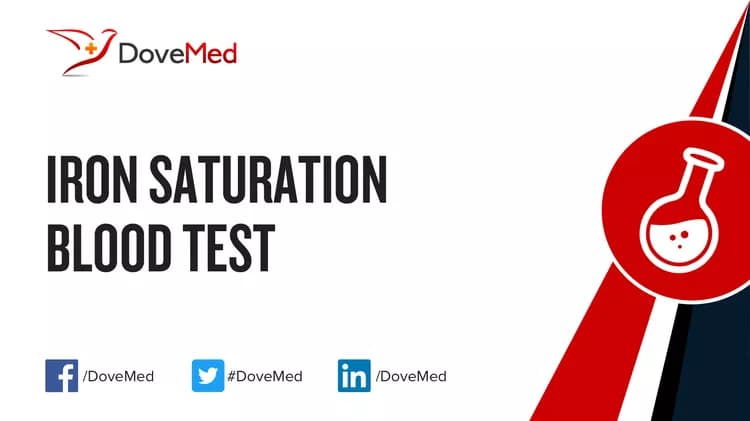What are other Names for this Test? (Equivalent Terms)
- Fe Saturation Blood Test
What is Iron Saturation Blood Test? (Background Information)
- Iron saturation is an approximation of iron stores in the body. It takes into account 2 other indices: Serum iron and total iron binding capacity
- Ionic iron, Fe2+, is needed for proper red blood cell function. The red blood cells (RBCs) primarily transport oxygen from the lungs to the rest of the body. Freely dissolved Fe2+ is very toxic. Virtually no Fe2+ floats around in blood. Instead, iron is bound by proteins such as ferritin, transferrin, and hemoglobin
- Ferritin is found inside cells and provides in-cell storage of iron
- Transferrin migrates through blood and transports iron between body sites. Other carrier proteins exist, but transferrin carries up to 70% of the iron in blood. Total iron binding capacity (TIBC) refers to the total amount of iron being carried through the blood. Though proteins other than transferrin contribute to the TIBC, TIBC is often used interchangeably with transferrin
- Unlike ferritin and transferrin, hemoglobin (Hb) is more than a storage or carrier for iron. Hb is an oxygen-carrying protein comprising 96% of the dry weight of red blood cells (RBCs)
- Iron (or Fe) is at the center of Hb function. Iron provides structural support to hemoglobin. More importantly, however, it facilitates the change in structure that accompanies binding of oxygen by hemoglobin. This structural change allows further binding of oxygen to occur more easily, a trait termed cooperativity
- The cooperativity allowed by iron in Hb is important to a RBC’s ability to oxygenate tissues, because it allows for small changes in oxygen levels to have a large effect on RBCs’ binding effectiveness. In other words, it makes the process more like an on/off switch and less like a dim switch
- The Iron Saturation Blood Test measures the percentage of iron bound to transferrin. It is calculated by dividing the serum iron value by the TIBC value and multiplying by 100 (the inverse is the transferrin saturation)
- The value for the Iron Saturation Blood Test represents the amount of iron-binding sites that are occupied. This is a more accurate measure of iron stores than serum iron alone
What are the Clinical Indications for performing the Iron Saturation Blood Test?
Following are the clinical indicators for performing the Iron Saturation Blood Test:
- Differentiating between iron-deficiency anemia and anemia secondary to chronic disease
- Following up to other iron tests
- Fatigue, pale skin
- Dizziness
- Shortness of breath
- Heart abnormalities
- Joint pain
- Loss of libido
- Nausea and vomiting
- Abdominal pain
How is the Specimen Collected for Iron Saturation Blood Test?
Following is the specimen collection process for Iron Saturation Blood Test:
Sample required: Blood
Process of obtaining a blood sample in adults:
- A band is wrapped around the arm, 3-4 inches above the collection site (superficial vein that lies within the elbow pit)
- The site is cleaned with 70% alcohol in an outward spiral, away from the zone of needle insertion
- The needle cap is removed and is held in line with the vein, pulling the skin tight
- With a small and quick thrust, the vein is penetrated using the needle
- The required amount of blood sample is collected by pulling the plunger of the syringe out slowly
- The wrap band is removed, gauze is placed on the collection site, and the needle is removed
- The blood is immediately transferred into the blood container, which has the appropriate preservative/clot activator/anti-coagulant
- The syringe and the needle are disposed into the appropriate “sharp container” for safe and hygienic disposal
Preparation required: No special preparation is needed prior to the Iron Saturation Blood Test.
What is the Significance of the Iron Saturation Blood Test Result?
The significance of the Iron Saturation Blood Test result is explained.
- A high value (greater than 50%) for the test may point to a diagnosis of:
- Hemochromatosis
- Hemosiderosis
- Thalassemia
- Use of birth control pills, if the value is between 50% and 75%
- Iron ingestion
- Vitamin B6 deficiency
- Aplastic anemia
- A low value (less than 20%) for the test may point to a diagnosis of:
- Iron-deficiency anemia (less than 10%)
- Anemias of infection and chronic diseases, such as uremia, rheumatoid arthritis, and some cancers
- Malignancies of the stomach and small intestine, which can result in iron deficiency due to excessive bleeding
The laboratory test results are NOT to be interpreted as results of a "stand-alone" test. The test results have to be interpreted after correlating with suitable clinical findings and additional supplemental tests/information. Your healthcare providers will explain the meaning of your tests results, based on the overall clinical scenario.
Additional and Relevant Useful Information:
- Only about 10% of dietary iron is actually absorbed in the body
- Because of the body’s ability to store iron, supplementation with iron may result in iron overload and toxicity
- Foods rich in iron include red meats, egg yolks, liver, and dark green vegetables
Certain medications that you may be currently taking may influence the outcome of the test. Hence, it is important to inform your healthcare provider, the complete list of medications (including any herbal supplements) you are currently taking. This will help the healthcare provider interpret your test results more accurately and avoid unnecessary chances of a misdiagnosis.
The following DoveMed website links are useful resources for additional information:
https://www.dovemed.com/common-procedures/procedures-laboratory/tibc-uibc-transferrin-blood-test/
https://www.dovemed.com/common-procedures/procedures-laboratory/iron-panel-tests/
Please visit our Laboratory Procedures Center for more physician-approved health information:
http://www.dovemed.com/common-procedures/procedures-laboratory/
Related Articles
Test Your Knowledge
Asked by users
Related Centers
Related Specialties
Related Physicians
Related Procedures
Related Resources
Join DoveHubs
and connect with fellow professionals


0 Comments
Please log in to post a comment.